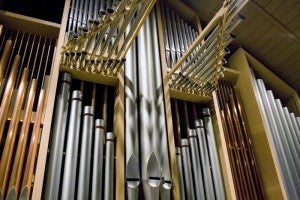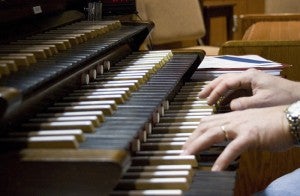It’s instrumental
Published 8:05 am Sunday, November 27, 2011

Grace Lutheran Church Music Director Bob Tewes plays a piece on the church's organ Friday. -- Sarah Stultz/Albert Lea Tribune
Up in the balcony at Grace Lutheran Church stands an instrument rich in history and sound.
A Schlicker organ, the instrument is patterned after ones in Germany, giving baroque sounds that are crisp and bright, according to Grace Lutheran Church’s music director Bob Tewes.
It is featured each week at the church’s regular worship services and accompanies the church’s adult choir. It is also a highlight at weddings in the church, is played during Albert Lea Cantori concerts and is used for private teaching purposes.
“It’s pretty well known up in Minneapolis as a fine instrument worth listening to,” Tewes said.

This Schlicker organ was installed at Grace Lutheran Church in 1971 after a fire at the church in the 1960s. There are 1,895 pipes ranging from as small as a pencil to 16 feet in length.
One of the three largest organs in Freeborn County, the Grace Lutheran organ has 38 ranks. The area’s other two large organs are at First Lutheran Church and United Methodist Church.
The First Lutheran organ has 52 ranks. The United Methodist organ has 35. Each produces a different sound.
Made up of 1,895 pipes, the Grace Lutheran organ is known for its high caliber, he noted. It contains both exposed and enclosed pipes ranging in size from as large as 16 feet tall to others as small as a pencil in diameter that are encased behind the organist. It also contains horizontal trumpet pipes, which can give off the sound of trumpets.
He estimated it would cost in excess of $1 million to replace.
“You’d have to go to the Cities or Rochester to see something of this caliber,” Tewes said.
What also makes it different than some, he said, is that it is mechanical, meaning it operates through the use of trackers. When the organist pushes down a key, this pushes down a lever, which ultimately leads to the sound. With electrical organs, like at United Methodist, the sound is more instantaneous.
Tewes, who has played organ for at least 30 years, said the tracker-style organs give the musician more control and gives a different sound compared to electrical organs. First Lutheran Church’s organ is also a tracker-style organ.
Grace Lutheran’s organ was installed in 1971, after the church had a fire in the 1960s. It was manufactured in Buffalo, N.Y., but was voiced with actual Germans who were sent here to set it up for the church.
“It was really to God’s glory to seek out the best for the congregation,” Tewes said.
About a year and a half ago it underwent renovations, where every single pipe was taken out and assessed and then put back in. Any problems were corrected, and Tewes said it plays like new.
He noted that people from out of town come to look at the organ, and many are impressed with its sound and appearance. He said the instrument is, of course, fun to play.
It is serviced by Obermeyer Organ Co. out of Burnsville.
By the numbers:
- 1,895 Pipes in the Grace Lutheran Church organ.
- 1971 Year the organ was installed at the church.
- 38 Ranks the organ has.
- 16 Feet of the longest organ pipes at the church.
Glossary of organ and church terms:
- altar: In many churches, it is the table on which clergy use for communion.
- chancel: The front part of the sanctuary where the service is conducted, often a few steps up from the nave.
- console: The unit that contains the keyboards, pedalboards, stops, music rack and other things the organist needs to play the instrument, often located in the chancel.
- coupler: A control in the console that connects keyboards and connects their divisions. Couplers can allow one keyboard to draw upon the stops of another keyboard, and they can essentially permit the extension of a keyboard to another.
- encased: Pipes that are behind wooden cabinets, creating a resonating effect.
- enclosed: Pipes that are in an enclosure called an organ chamber.
- exposed: Pipes that are visible to the congregation and are not encased or enclosed.
- division: The pipes are divided into sections called divisions and correspond to certain keyboards. The divisions, and thus the manuals, often have different names. Common ones are great, swell, choir, solo, orchestral, echo and antiphonal, though other names can be found. Couplers connect divisions to selected keyboards.
- key action: Organs operated with electricity are different than ones that use mechanisms. The United Methodist Church organ is electrical. The Grace Lutheran Church organ is mechanical. Specifically, the Grace organ uses trackers.
- lectern: In churches, the two speaker stands at the front, the one that primarily functions as a reading stand or for announcements is the lectern. Traditionally, as viewed from the nave, it is on the right.
- manual: Keyboards in the console meant to be played by the hands.
- mixtures: Stop keys that allow multiple ranks to play together.
- nave: The area where the congregation gathers to worship, often seated on pews.
- narthex: The lobby or entryway of the church.
- pedalboard: A keyboard in the console meant to be played with the feet.
- pulpit: In churches with two speaker stands at the front, the one that primarily functions as for preaching the sermon or reading the Gospel. Traditionally, as viewed from the nave, it is on the left. In churches with a single speaker stand, technically, it is an ambo (Greek for “both”) but commonly called a pulpit anyway.
- rank: A row of pipes with the same kind of sound, each pipe producing a different note. Each rank produces a different tone or pitch. For instance, one rank produces the sound of, say, a clarion and another the sound of a trombone and another a trumpet. Ranks are made available by the stop keys.
- sanctuary: Traditionally meaning the most sacred part of any religious building, in a church it was the area immediately around the altar. However, in modern times it has come to mean the large room of worship, comprising the chancel and nave.
- sforzando: A control that activates all of the stops and couplers instantly, sometimes labeled “full organ” or “tutti.”
- stop: A sound available on the organ made by a single rank or multiple ranks. Stop keys at the console are often called stops, too.
- tracker: A long piece of thin wood used in mechanical organs to open a valve.
- valve: The means by which, when opened or closed, air enters an organ pipe.
- voice: How well the pipes sound together. Voicing is the process of adjusting the pipes to produce consistent and correct tones.
— glossary by Tim Engstrom





